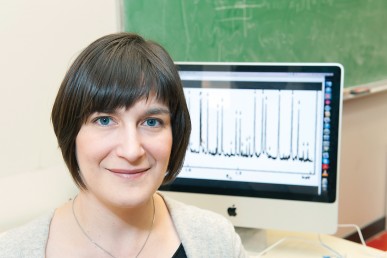Mathematician seeks new ways to analyze real-world problems

Irina Nenciu: random matrices are “a hot topic in math.” Photo: Roberta Dupuis-Devlin/UIC Photo Services (click on image for larger file size)
By Paul Francuch
Mathematician Irina Nenciu has taken on the challenge of analyzing connections among complicated mathematical equations and techniques — hoping to find better ways to analyze real-world problems, ranging from the economy to the bunching-up of city buses during rush-hour.
Nenciu received a five-year $500,000 National Science Foundation Early Faculty Career Award to study, specifically, “long-time asymptotics of completely integrable systems with connections to random matrices and partial differential equations.”
She chuckled when asked to put that in terms that are understandable to a non-mathematician, then broke it down one mouthful at a time.
Differential equations examine the relationship of variables and functions, she said. While useful in explaining certain phenomena in science, engineering and economics, they are complicated, and understanding their solutions is the subject of ongoing study.
“I look at questions of: what do solutions look like for very large times?” said Nenciu, assistant professor of mathematics, statistics and computer science.
“Assume you let a long time go by — is there some structure in the solution that always emerges, regardless of where you start from? Do you see something that one recognizes?”
“Asymptotics,” she said, “is just a fancy word for the long-time behavior of the solutions, and how you can make predictions from what you’re given.”
Random matrices are mathematical arrays of numbers or symbols representing random values. They are tools used widely in Nenciu’s specialty, mathematical physics.
“They’re a hot topic in math,” Nenciu said
In economics, random matrices are used to understand certain behavioral outcomes. Other examples include the optimal pacing of buses to prevent bunching, or the quickest airliner passenger-boarding procedures.
She said random matrices and integrable systems are mathematically similar techniques, but the direct connections are not clear.
“It looks coincidental, but it’s proved to be so useful that most of us believe there’s something deeper behind it,” Nenciu said.
“We’re trying to understand that connection through a problem that tries to evaluate how efficient various numerical algorithms are.”
